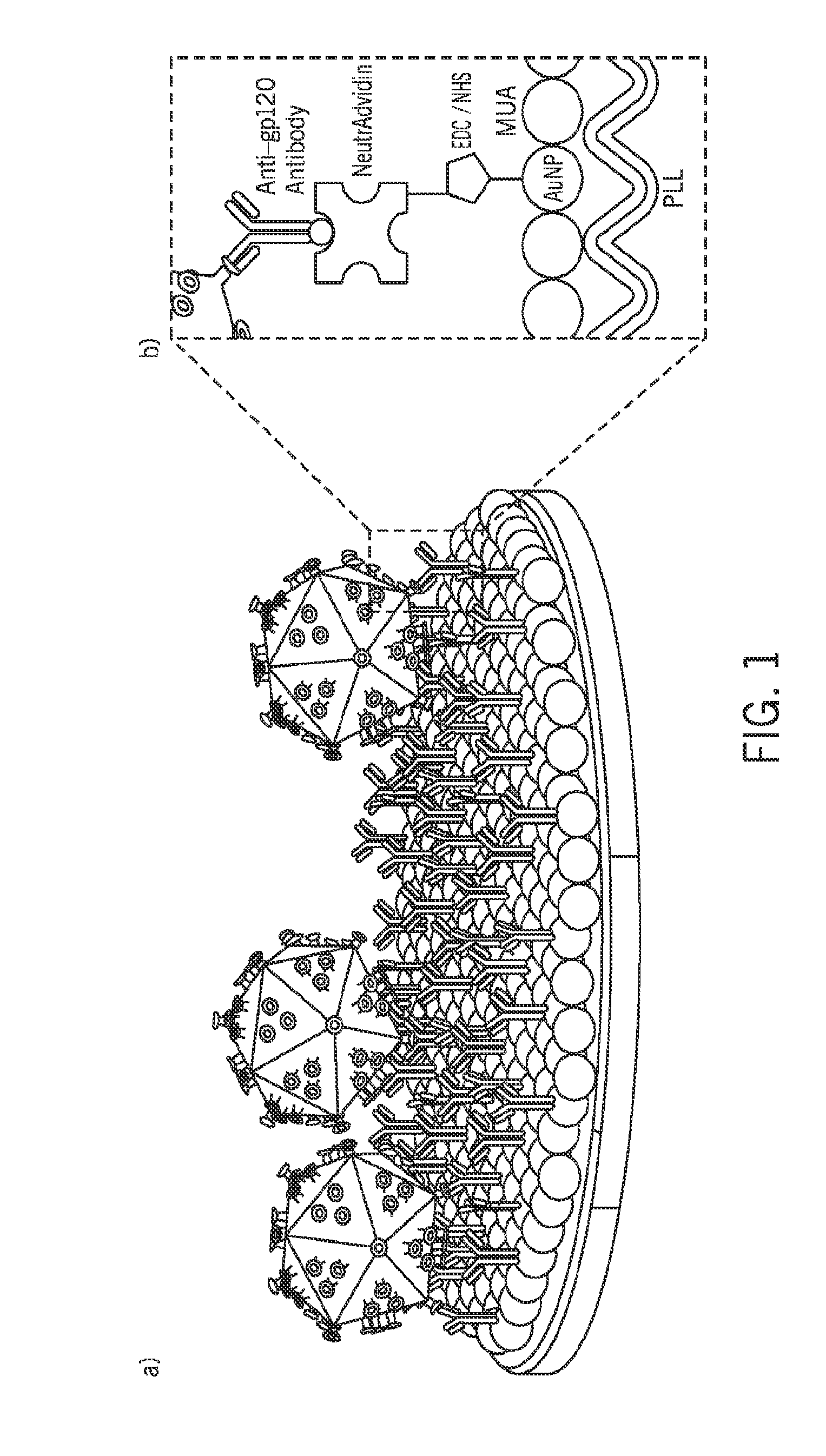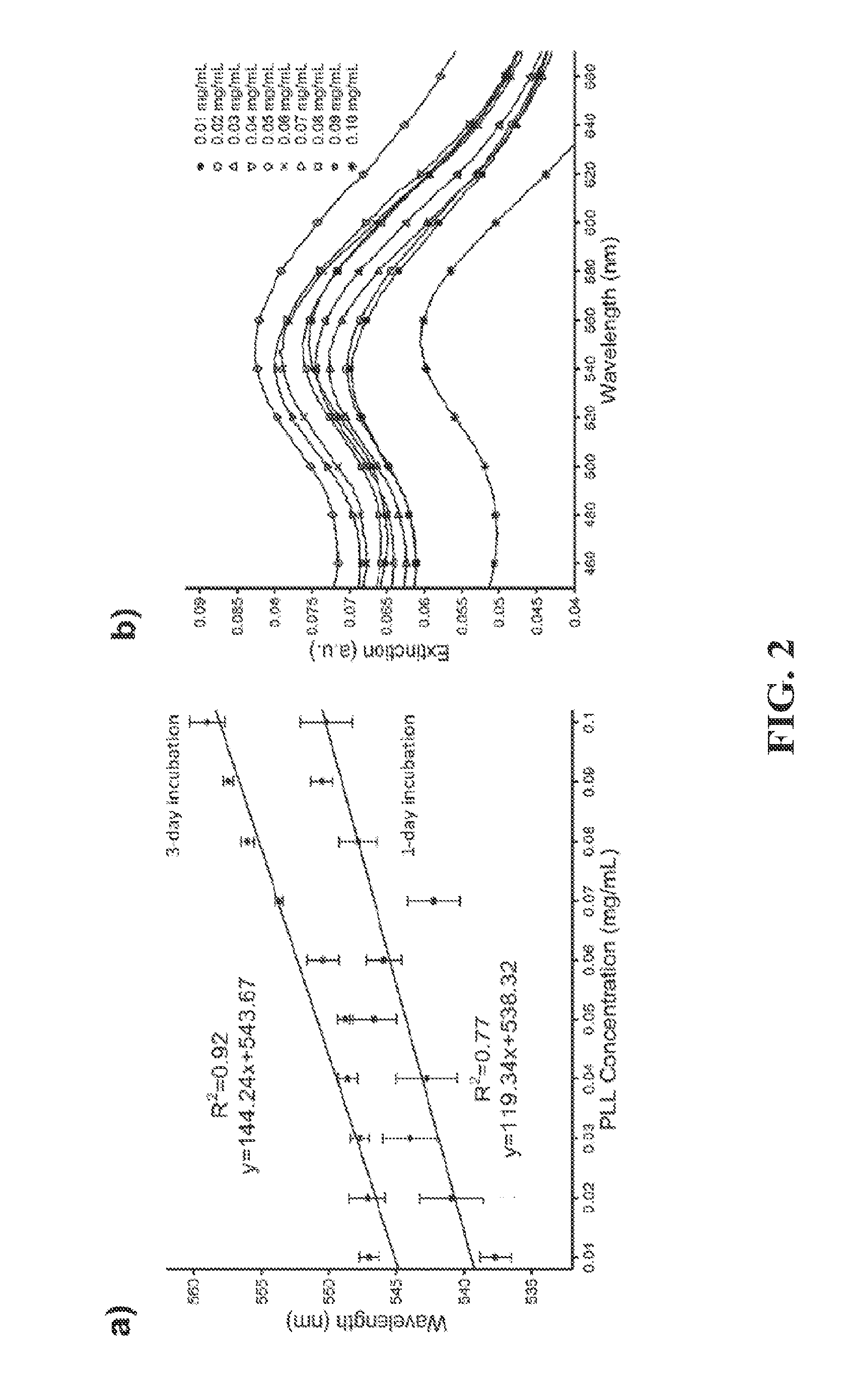Detection, Capture and Quantification of Biological Moieties from Unprocessed Bodily Fluids Using Nanoplasmonic Platform
a technology of biological moieties and nanoplasms, applied in biochemistry apparatus and processes, instruments, peptides, etc., can solve the problems of omnipresent dangers of sars and hiv to global health
- Summary
- Abstract
- Description
- Claims
- Application Information
AI Technical Summary
Benefits of technology
Problems solved by technology
Method used
Image
Examples
example i
[0061]Referring first to FIGS. 1A and 1B, a nanoplasmonic viral load detection platform is illustrated. FIG. 1A shows the capture of HIV on the antibody immobilized biosensing surface and FIG. 1B illustrates the structure of the nanoplasmonic platform and various layers. The construction of the exemplary nanoplasmonic platform is now described along with data characterizing of the platform, including some intermediate forms of the platform.
[0062]The nanoplasmonic platform is constructed using a polystyrene surface as a base substrate. For the prepared trials, polystyrene well plates were purchased from Corning Inc. of Corning, N.Y. The polystyrene surfaces were first washed with absolute ethanol and distilled water, then dried under nitrogen gas. The ethanol (200 proof) was purchased from Fisher Scientific of Fair Lawn, N.J. Following cleaning steps, the polystyrene surface was modified by poly-l-lysine (PLL) to form amine-terminated groups. A series of densities of PLL (from 0.01 t...
example ii
[0068]To evaluate gold nanoparticle binding and seeding on polystyrene surface, a series of poly-l-lysine (PLL) concentrations (0.01 to 0.1 mg / mL) were evaluated and a linear concentration-dependent wavelength shift was observed as illustrated in FIG. 2A. The preparation of the surfaces to evaluate gold nanoparticle incubation time on amine-terminated polystyrene surface was performed with 1-day and 3-day incubation steps. FIG. 2A shows a statistically comparable correlation between wavelength shift and PLL concentration for 1-day and 3-day incubation steps. Based on these results, it was established that the experiments could be prepared using the 1-day incubation of PLL to decrease the incubation time for the preparation of the devices.
[0069]As shown in FIG. 2A, the individual wavelength of bare gold nanoparticles shifted from 518 nm to 546.4±1.6 nm, when PLL concentration (1-day incubation) was increased from 0.01 to 0.1 mg / mL. The number of amine groups played a notable role in ...
example iii
[0072]At each surface modification and after an HIV capture step, spectral analysis was monitored by either curve fitting analysis or experimental data maximum method, which reports the peak shifts at the maximum extinction wavelength. Each binding study was characterized with a detected shift of the maximum extinction point of gold nanoparticles by Varioskan® Flash Spectral Scanning Multimode Readers, Thermo Scientific. The measuring mode was set to scan the extinction changes per wavelength from 400 nm to 700 nm over 301 steps. The detection light beam area of the spectrometer was indicated as 3.14 mm2 (maximum). The spectral resolution and intensity accuracy of the instrument with fixed slit setting was 1 nm and 0.003 a.u. extinction intensity. We performed 6 replicates for nanoplasmonic measurements for all samples.
[0073]To analyze the wavelength data, we employed two approaches (i.e., curve fitting and experimental data maximum). In the first method, a software code (e.g. MATLA...
PUM
| Property | Measurement | Unit |
|---|---|---|
| assay time | aaaaa | aaaaa |
| densities | aaaaa | aaaaa |
| diameter | aaaaa | aaaaa |
Abstract
Description
Claims
Application Information
 Login to View More
Login to View More - R&D
- Intellectual Property
- Life Sciences
- Materials
- Tech Scout
- Unparalleled Data Quality
- Higher Quality Content
- 60% Fewer Hallucinations
Browse by: Latest US Patents, China's latest patents, Technical Efficacy Thesaurus, Application Domain, Technology Topic, Popular Technical Reports.
© 2025 PatSnap. All rights reserved.Legal|Privacy policy|Modern Slavery Act Transparency Statement|Sitemap|About US| Contact US: help@patsnap.com



